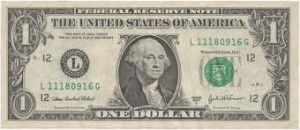As we all know, money doesn’t grow on trees. Not even paper money is made from the pressed wood pulp that provides us with the other sorts of paper that we use every day.
Paper money – at least the sort that’s used in the UK, the USA and the Eurozone – is made from cotton or linen (sometimes known as ‘rag paper’). Rag paper contains far fewer acids than wood pulp, so it doesn’t discolour or wear out as quickly as paper made from wood pulp. In addition, during the money-making process, the rag paper cloth is infused with gelatine to give it extra strength – but that still only means that the average life of a banknote is some two years.
Some years ago, someone calculated that, if you took the national debt of the USA – then some $7 trillion – and converted it to one dollar bills and placed them one on top of another, the resulting pile would reach from Capitol Hill in Washington DC to the Sea of Tranquility on the Moon and back again. This was an inventive and memorable way of illustrating the size of the USA’s national debt – although, with the USA’s current national debt now standing at some $16 trillion and rising rapidly, the pile of dollar bills would now make at least four piles of banknotes to the Moon.

Or maybe, in the near future, the one dollar bills in this mythical image should be superseded by five dollar bills to keep the columns of banknotes to only two.
Anyway, as you can see, items of trivia can create a powerful hook for learning.
Short, sharp and, sometimes, silly facts provide our brains with the fun and interest we need in order to stay connected to the worthy but less-than-exciting learning materials that we’re studying.
Such an approach can be a real boon to the learning designer and to the graphic artist who’s illustrating the learning materials. Learners link these odd facts to parts of the learning content – especially if the facts are conveyed with an accompanying striking image.
Once the association is made, the picture and/or the trivia sparks the link to the content that may have been mundane without it.
Thus the hook is made and the learner’s longer term memory committed. The learning materials have become memorable – and, that time at least, the learning designer/ developer’s job is done.







Leave A Comment
You must be logged in to post a comment.